(Written by William)
In this Brick Breakdown series I review official LEGO sets, from the perspective of looking at interesting building techniques we can all learn from. Today we will be looking at the #10246 LEGO Creator Detective’s Office that became available just a few days ago. We have published an earlier review on this set that you can find here: LEGO Detective’s Office Review & Thoughts. You can also check out the previously discussed LEGO techniques found in official LEGO sets at the end of this article. 🙂
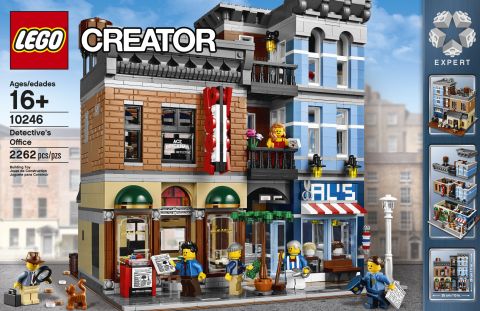
The case is on! Someone is smuggling candy and it’s up to the detective to figure out who is doing it and how. Above all, all this criminal activity is happening in a rather crammed little strip mall, where they can’t build out so they build up. Since this is a LEGO Modular Building I will definitely have to talk about a couple more things than normal, so prepare yourself for an extra long, extra special Brick Breakdown. 🙄
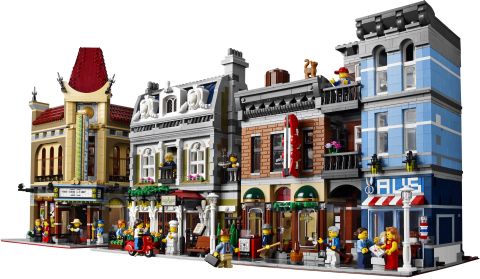
➡ LEGO DETECTIVE’S OFFICE – NEW ELEMENTS
Whether it is an old part in new color or a brand new LEGO element, new parts are one of the highlights of a new LEGO set. Some of the most notable of these are usually found in the LEGO Modular Buildings, and this is certainly true for the LEGO Creator Detective’s Office.
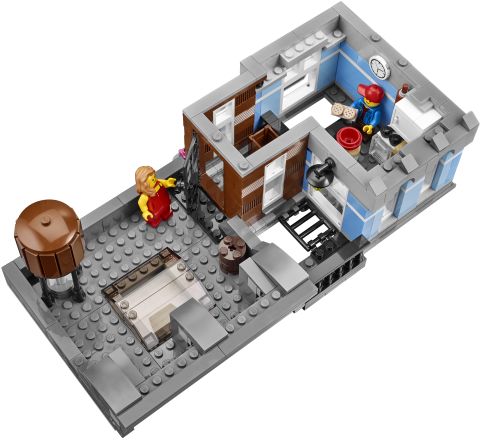
Starting small, we get a 1×1 round plate in black with an open stud (here you see them on top of the stove, but there are a lot more in the set). This element was first released in 2009, and since then appeared in white, yellow and dark-red. This is the first time we get it in black, so it’s a big deal. Although it is a small piece, LEGO fans instantly liked its applications. Its usefulness especially comes into play when you stick things in or trough the open stud. It turns any surface into a possible spot for mounting all types of elements.

Next up is the paint-roller in black. You may have picked up a light-gray one with the Collectible Minifigure Series 10 Decorator minifig, but having this element in black gives you some really classy ways to mount lights – like they have done at the front of Al’s Barber Shop.
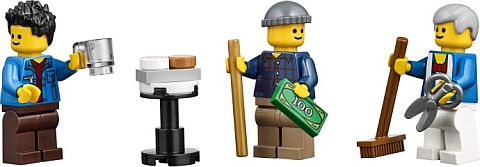
While we are on the subject of accessories, don’t forget the scissors! You get three pairs in this set. They kind of remind me of the two feathers you find with some of the Native American minifigs (or the dark-gray ones that are included in this set as darts), but they have a more solid bar for holding, and loops around the handle.
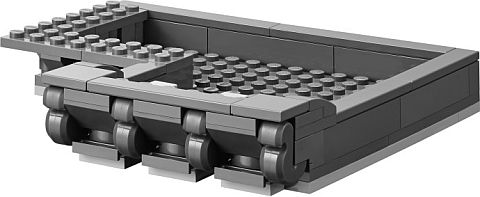
Another exciting new piece is Unikitty’s tail in dark-gray at the roof-line of the blue building. This was an application I was dying to try as soon as I saw the piece for the first time. Now we have this piece in a very easy to use color without the painted designs.
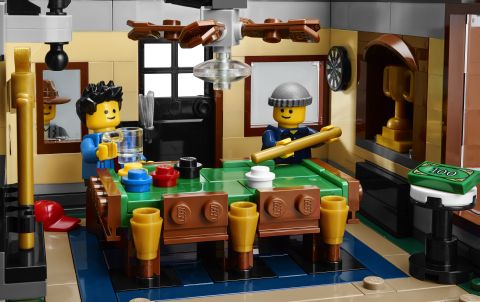
Then we have something that completely took me by surprise; a 2×2 round tile with a single open stud in the middle (so you can slide it on a rod). Two are included in this set and they are both white. One is in the pool-hall forming the top of a small corner table, and the other is on the third floor of the blue building, also used as a table-top (under the mixing-bowl). This is going to be an extremely useful piece that also appears in other sets.
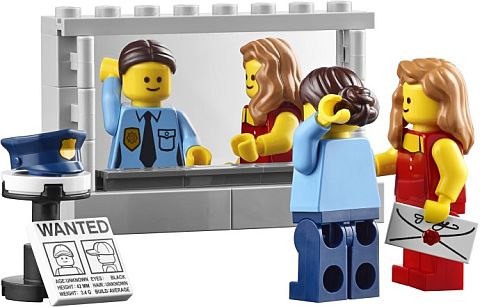
Moving on, we also get a true reflection-mirror. The piece actually doesn’t quite feel like plastic, more like a treated piece of cardboard. It is exactly the size and shape of a door so it will fit snuggly into a 4×6 stud door-frame. It does not have little nubs, so don’t expect it to lock into place, but it really doesn’t need it.
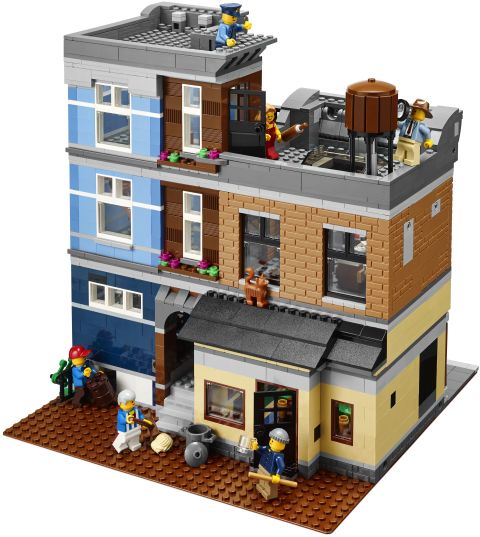
And last but not least, there is a 32×32 reddish-brown baseplate. We finally have the color we need to go digging in the dirt! There are other pieces that are new – like the many printed tiles and windows – but those are more of a visual treat than anything else. So I’ll leave those for you to enjoy. And now it’s time to move to building techniques!
➡ REPETATIVE LEGO PART USAGE
Certain LEGO elements are ideal for making patterns. Slopes are a great example of this; put them in the same direction and you get a roof. Change the color and you get a colorful awning. Put them back to back and you get an interesting high-low pattern.
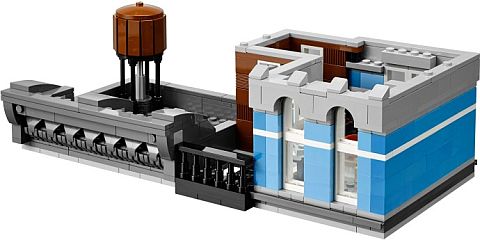
The LEGO Creator Detective’s Office teaches us that sometimes a pattern will only emerge with persistence. Take for example the standard LEGO Hero Factory fist that is used in the roof-line of the left building. It is a fist, and it’s hard to imagine it as anything else. But connect eight of them together with small red axles, and line them up at the top of a building, and they look like very impressive detailing.
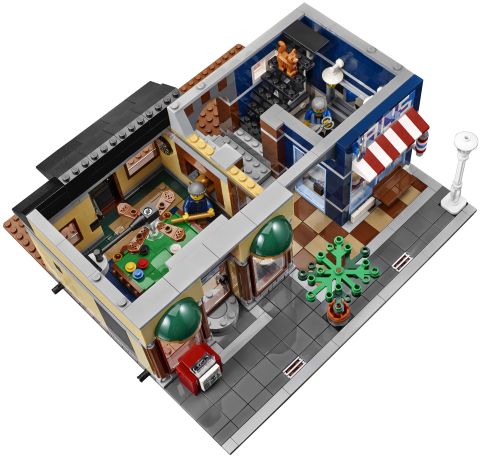
Another interesting thing about repetitive usage of a particular element is that you may find additional functionality for it. Take for instance the ski/snow-shoe piece. We learned in the #10229 LEGO Winter Village Post Office set that two snow-shoes can be placed bottom-to-bottom and their back end will form a bar that fits in standard LEGO holes. And when you keep repeating this pattern a few times what you get is fan blades for a ceiling fan!
The important thing for figuring out patterns is how to use a piece over and over again. Sometimes all is needed is changing how a part is orientated. Generally the idea is that if you use an element enough times, it will make some kind of a pattern. I suggest using about eight copies of the same piece for some basic experimentation.
➡ BUILDING WORDS WITH LEGO
In the past when LEGO designers built words out of LEGO elements the usually used a mosaic approach. In doing so, they basically pixilated the letters and used colors to spell things out. The reason for this had to do with the fact that LEGO elements are traditionally awful at handling curves – which are very prominent in the Roman alphabet.

Now that we have a round tile with a hole in the middle, things have changed. Just by using the shape of these elements we can now stack things in such a way that the pieces themselves can stand for particular letters. Essentially, what we end up with here is a new LEGO font type we can play with when building signs. You may also want to get some 4×4 round plates with a 2×2 hole cut out of them when you play with this technique. This set has that piece in the pool -hall’s front doorstep, if you need to see what it looks like.
➡ SPLITTING A LEGO SIDAWAYS BUILD
A long time ago I talked about the 2 to 5 rule, that is; every two studs equals five plates of thickness. This is the basis for most sideways building techniques. However I have never thought about splitting this up! And this is exactly what’s done in the AL’S barber sign. For starters, the area is prepared with a 2×3 tiled section – this is done twice. Then on either side are two bricks worth of pieces. Since the center is raised with a tile, what you end up with is a space with a 2×3 footing and five plates high.
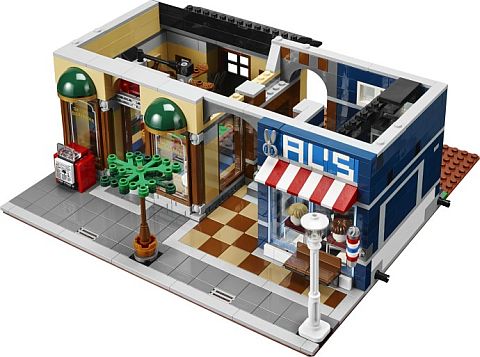
This is not bad, but 3 studs don’t break into an even number of plates. So LEGO designers built a bar that goes across the upper back of each area. This is odd but it in fact makes all the difference. Essentially this method allowed elements to be clipped into place using modified 1×1 plates with either vertical clips (if sideways) or horizontal clips (if straight up and down). I don’t have a picture of this section, but you can find a close-up of it in the video-review below by the BrickShow.
This construction means that a normal stud thickness could be inserted into a sideways build, thus splitting it up into parts. So instead of a straight stack of five plates you get a stack of two plates, then a stack of normal 1×1 plates, and finally the other three sideways plates. The end result is amazing. It allows us to build detailed lines that are thin in the direction we like. The sideways elements make beautiful vertical lines while the normal stacked plates make the horizontal lines. I definitely recommend studying how this sign is made.
➡ LEGO CHAIN TREAD LINKS
If you are like me, chances are you stick to a certain style of pieces like LEGO System. This means you don’t see some pieces used in other LEGO systems all that often. The interesting thing is LEGO makes sure that pieces all have some sort of connectivity; no matter if they are in LEGO Hero Factory, LEGO Technic, or in the regular LEGO System line. In the LEGO Creator Detective’s Office there is a great example of this in the form of the water tower on the roof. See how nicely round all those tiles are? Those are 1×3 tiles mounted onto tread chain-links. This assembly of chain-links with the attached tiles is then wrapped around a gear, which is in turn attached to an axle and connected to the roof in usual ways.

The long and short of this example is that these treads can hold all sorts of 1x? plates. 1×3 is the smallest it can hold, but anything larger can be accommodated. The reason this is important is because you get an incredible amount of flexibility in a chain that is practically organic in the way it looks. So if you are at all interested in making fascinating curves you may want to check out this water tower construction more closely.
➡ APPLYING WHAT YOU LEARN
New LEGO pieces are always exciting. They are the groundwork for those who like to innovate with LEGO. Just keep in mind that much older and forgotten pieces also have the potential to be reinvented with a new piece. Those who build big know that the key to many great designs is all about having enough pieces of the same type. Many times a builder is held back by having so few of a piece that an idea gets left out – not because it wouldn’t work, but because it’s so easy to run out of pieces. A good number to experiment with is eight, but you’re definitely going to want more if you find a pattern that you like.
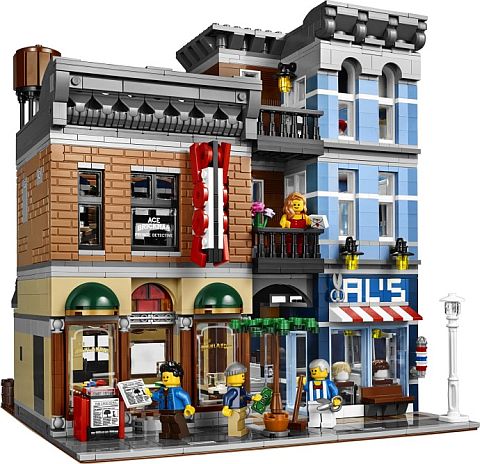
Building words and splitting sideways designs are marks of expert level work. They represent a familiarity with size, shape, and space that lets a builder create some highly unusual creations. Finally, something like a chain-tread is just worth mentioning because of the unusual way it is being used in this set. LEGO fans have used this method before, but this is the first time it has shown up in an official LEGO set in this manner. It is a great showcase for a rarely used technique. Putting it into your own designs will more than likely change how you view shapes in your own LEGO creations.

So what do you think? How do you like the new LEGO Creator Detective’s Office? Did you get it yet, or are you planning to? And did you learn from the interesting building techniques used? Feel free to share your own experiences and tips, or ask questions in the comment section below! 😉
And you might also like to check out the other reviews in this series:
- Brick Breakdown: LEGO Minecraft Ender Dragon
- Brick Breakdown: LEGO Santa’s Workshop
- Brick Breakdown: LEGO Ideas Exo Suit
- Brick Breakdown: LEGO Ideas Research Institute
- Brick Breakdown: Emmet’s Contruct-O-Mech
- Brick Breakdown: LEGO Forest Animals
- Brick Breakdown: LEGO King’s Castle
- Brick Breakdown: LEGO Cinderella’s Castle
- Brick Breakdown: LEGO MetalBeard’s Sea Cow
- Brick Breakdown: LEGO MetalBeard’s Duel
- Brick Breakdown: LEGO Minecraft Sets
- Brick Breakdown: LEGO Disney Princess Sets
- Brick Breakdown: LEGO Back to the Future DeLorean
- Brick Breakdown: The LEGO Movie Ice Cream Truck
- Brick Breakdown: LEGO Parisian Restaurant
- Brick Breakdown: The LEGO Movie Flying Flusher
- Brick Breakdown: LEGO The Hobbit Dol Guldur Battle
- Brick Breakdown: LEGO Winter Village Cottage
- Brick Breakdown: LEGO Winter Village Market
- Brick Breakdown: LEGO Lord of the Rings Council of Elrond
- Brick Breakdown: LEGO Castle Dragon Mountain
- Brick Breakdown: LEGO Lord of the Rings Pirate Ship Ambush
- Brick Breakdown: LEGO Ninjago Golden Dragon
- Brick Breakdown: LEGO Superman Black Zero Escape
- Brick Breakdown: LEGO Tower of Orthanc
- Brick Breakdown: LEGO City Dump Truck
- Brick Breakdown: LEGO Monster Fighters Ghost Train
- Brick Breakdown: LEGO Lone Ranger Silver Mine Shootout
- Brick Breakdown: LEGO Lone Ranger Constitution Train Chase
- Brick Breakdown: Ninjago Temple of Light
- Brick Breakdown: LEGO Lone Ranger Colby City Showdown
- Brick Breakdown: LEGO Lone Ranger Comanche Camp
- Brick Breakdown: LEGO Lone Ranger Stagecoach
- Brick Breakdown: LEGO Star Wars AT-RT
- Brick Breakdown: LEGO Arkham Asylum Part 1
- Brick Breakdown: LEGO Arkham Asylum Part 2
- Brick Breakdown: Legends of Chima Polybags












I saw this set at target, and I almost bought it, if it weren’t for the fact that cost $90. So I went for the toy and grocery shop (31036) about half that price.
Not sure what country you’re in but $90 is a steal. That set goes for $159.99 normally in the U.S.
My guess is that’s a mistake. The set is not sold at Target, and it is not $90. Tenny probably mixed it up with something else. Perhaps one of the regular Creator houses?
You’re probably right. It looked like a modular build but I didn’t pay much attention to it.
I’m so excited!!! I got an email from my Bricklink wanted list for Pizza To Go for $19.99. I think it normally goes for like $30-$40 so when I saw it I jumped on it. It’s a set I always wanted. =D
Oh, that’s a lovely old set! What a nice find! 😛
Nice review. You did a good job of bringing out some of the details that are easy to miss.
One minor point:
“The reason for this had to do with the fact that LEGO elements are traditionally awful at handling curves – which are very prominent in the Arabic alphabet.”
Don’t you mean the Roman alphabet?
Yeah, I’m pretty sure that’s what William meant. I have corrected it for him. Thanks for catching that! 🙂
Might have been a mixup with “Arabic numerals”…
The round tile isn’t ‘that’ useful for other letters than O, though…
Very well could have been. The round tile is also used for the P, so it is useful for those kind of letters too. 🙂
Great review. I hadn’t noticed that about the letters on Al’s sign before…I had thought they were the same kind as on the Pet Shop. The new one is pretty sweet… I must try that sometime. I certainly like the part content of the set (including the new pieces I know well). I didn’t know about how the water tower was built… all the reviews I’ve read have skipped over that. So, do the 1×4 tiles just snap on top of each track link, or are they connected by a shaft or axle or something? 😕 Too bad my brother called this, although I’d still rather get the Parisian Restaurant. 😐
The Al’s sign is quite similar to how the Pet Shop sign is built. If you watch the BrickShow review there are some views where you can see the back fairly clearly. If it is still not clear, I could take some pictures. As far as the water-tower, I’m surprised that others haven’t mentioned it. It is a brilliant design. The track-links are wrapped around a gear with a Technic axle through it that connects it to the roof. The tiles are just snapped on the track-links around the gear. The constructions is capped with an upside-down round plate on the bottom and a dish on top. The plate is upside down so the four “legs” can connect to it (they are also upside down). Because of how everything is connected the whole thing is extremely solid. You would think it would be a bit shaky because of those skinny legs, but it isn’t. That water-tower is totally bullet-proof (and little-brother-who-not-supposed-to-touch-my-stuff proof). 😛
Very cool I haved used the tread thing before thow.
Sorry I havent been on much I’m on a tropical island.
Are you in the Caribbean? Love the place! 😛
yes I was just got back!
Wow, I really goofed there. Yes, I was thinking numbers at the time. It is indeed Greek letters.
The tiles on the treads are 1×3 which is almost impossible to tell size wise just from the pictures. That is key since that is the smallest length of tile that can fit on the tread.
On the backs of the 1×3 and larger plates and tiles there are those solid tubes. The tread partially uses that as well as fitting snuggly inside the plate/tile to grip the piece.
I was talking with a friend about the technique and he said this was the first time he had seen it in an official LEGO set, but that it was readily used in fan MOCs.
I’m just hoping that now that we have the doughnut tile we will get some macaroni tiles to help build even larger letters.
Wait… so its the Greek alphabet, not Roman, right? That sounds right, I never thought the Romans were smart enough for inventing alphabets (no offense to any Romans, though 😉 ).
It seems the 1×3 tile on track link is an illegal technique, as LDD doesn’t accept it. But then LDD doesn’t accept a lot of things. Still, that is the most interesting building technique I have seen in recent LEGO sets, and I think I will try it out. 🙂
What exactly would a macaroni tile look like? Like an ‘S’?
Our alphabet is actually usually called the Latin alphabet, also referred to as the Roman alphabet, as that’s what it was developed from. The Greek alphabet is quite different. I think we are all a little confused here. 🙄
I made this piece and I am very excited – the structure, the colors, the tiny details are marvelous. This is the first Lego item I have bought since I was a kid, but I saw it in the Lego Store and was instantly interested. It was so much fun building this.
It seems that the other modular buildings are smaller than this one. I am thinking about buying the Parisien Restaurant but it seems much smaller than the detective’s office. Has anybody have these 2 already and do they match.
Best regards,
Johan
Johan, glad to hear you had fun with this set. It is also one of my favorites. Please note that all LEGO Modular buildings match. The Detective’s Office is actually the smallest that was ever released in the series (something a lot of LEGO fans are not happy about). The Parisian Restaurant is the same height as the light-blue building on the right side of the Detective’s Office. So is the Pet Shop. And the other buildings are even taller, with the Town Hall being the tallest. In my previous review of this set there are some comparison pictures that can help you see the size: http://thebrickblogger.com/2014/12/lego-detectives-office-review-thoughts/